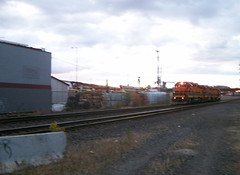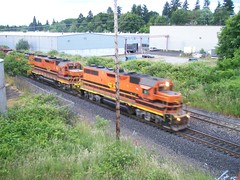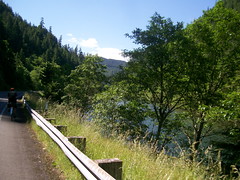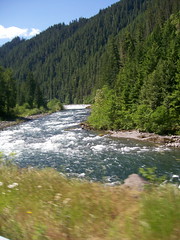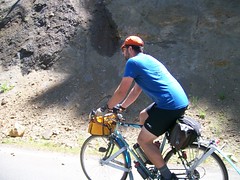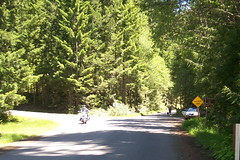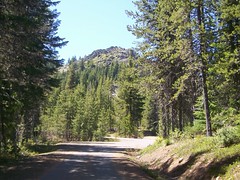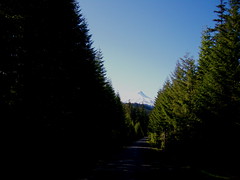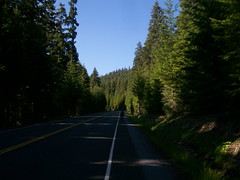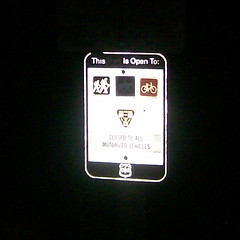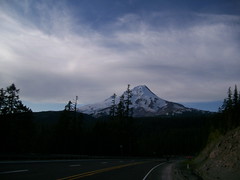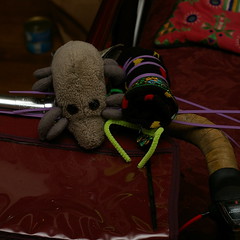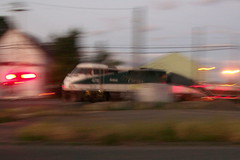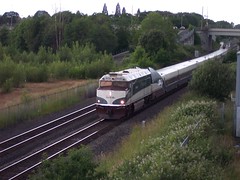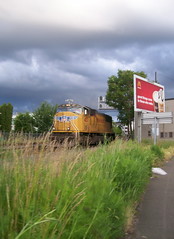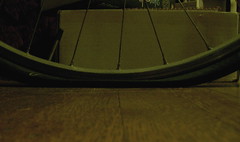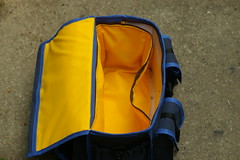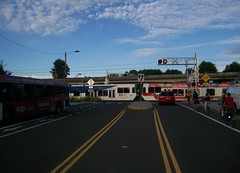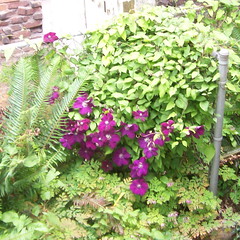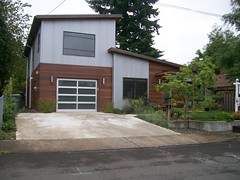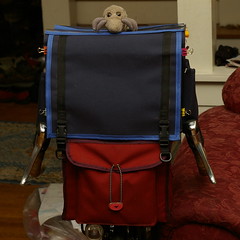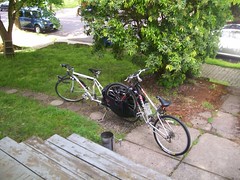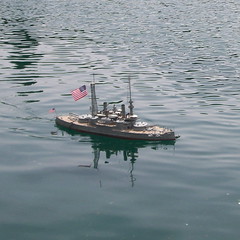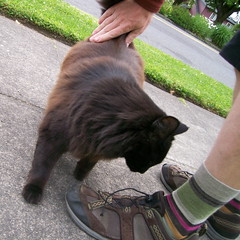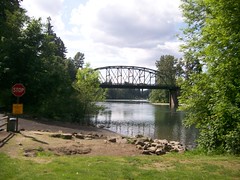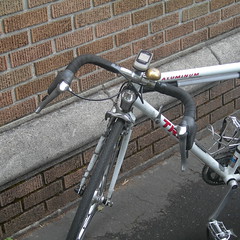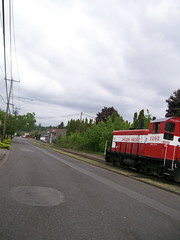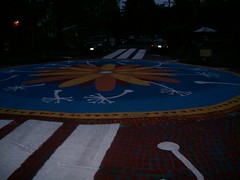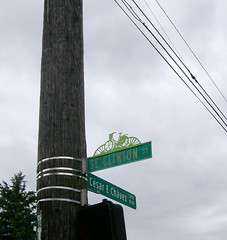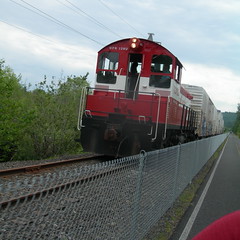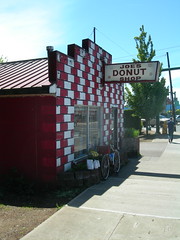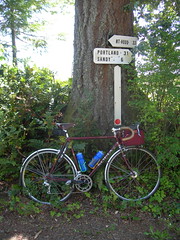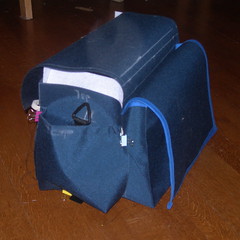Jun 30, 2011
Three P&W Geeps run light in the direction of Brooklyn Yard.
—orc Thu Jun 30 22:38:32 2011
Jun 29, 2011
Notice how the camera carefully focussed on the utility pole in front of the lead locomotive? It’s that sort of photographic detail that makes a CBC a CBC.
—orc Wed Jun 29 22:26:41 2011
Last week, before I rode up to Mount Hood, I made plans with my friend Theo to ride the Hills to the Yeah! permanent yesterday.
So, despite unhappy sounds from my legs, Theo and I rolled out the door (of Marsee Baking, which makes a lovely starting control for a loop) at 7:40am for a run up and down the hills south & east of Portland.
Unlike Saturday, it was cloudy. And unlike Saturday, I had already been out climbing (on a route I’d love to do again soon, but first I’ve got to massage the cuesheet and submit it to RUSA) for a while, so the loop consisted of Theo and I rocketing along on the flats (Theo is really fast, and when I’m having a good day I can just keep up with him. On an ordinary day, about the only way I can keep up with him is by aggressively tagging along in his slipstream. Today was an ordinary day) and then my slowing to a glacial crawl every time we hit a hill, while he zipped up and out of sight, only to cool his heels for 5-10 minutes until I staggered into sight at the top of the ramp.
Some notable things about this loop were
- We moved along quickly enough to make it into the Canby control about 10 minutes after it opened, but then the hills between there and Sandy ate away so much time that we made it into Joe’s Donuts about 45 minutes before that control closed.
- Rain and chain waxing does not mix and I spent the last 40 miles of the loop going squeaky-squeaky along in Theo’s wake.
- Marine Drive can be pretty horrible when there’s a headwind. When there’s a tailwind, it’s not horrible in the least; Theo and I made the 21 miles from Troutdale to Kelley Point in just a hair over a hour (my best solitary time along there was about 1h15, but it’s easier to move right along when you’re in a paceline.)
- I’ve ridden Bull Run Road/Trout Creek Road enough now so I pretty much know where all the curves are on the descent down to just before the hairpins at Oxbow Park. On this loop, this meant that I could descend down that ramp at full speed, including taking at least one steep curve at 40mph (the pavement on these curves is not the best, and I get the weirdest-feeling floaty chattery vibration when I hit some of those sections at
line speed.)
- The climbing around the Buckner Creek watershed is still the nastiest sustained climb I’ve ridden. The only one that’s comparable is Slab Creek Road (north of Lincoln) and some of the awfulness of that may be the combination of rain+night+bad pavement.
- When my legs are tired I can’t bounce rollers faster than Theo does. Of the six nice
parabolic rollers up near Sandy, I think I only made it to the top of one of them first.
- When I reached the top of the Bull Run ramp, my brevet average was down to 9.6mph. When we reached the end of the line in Sellwood, our brevet average was up to 11.1mph (13.2mph moving average; faster for Theo, of course, because he spent half an hour or so waiting for me at the top of various inclines.)
Alas, there are not very many pictures this time around; it was drizzling most of the way across the ridge near Sandy, and then by the time the sun finally broke through I was too busy pacelining along Marine Drive to slow down and pull out the camera.
One strange thing is that despite my legs being so tired I still managed to get in the ballpark of my other times around the loop (yesterday was 11h17, and the previous loops were 11h03, 11h10, and 11h55.) It’s all about the climbing, I guess, and I need to keep doing more of it to get to the point where I can be not quite so embarrassingly slow winching my way uphill. Maybe I’ll try the loop on my trek next time around?
—orc Wed Jun 29 15:54:47 2011
Jun 28, 2011
I’d been using chain-L to lubricate the chains on both of my bicycles for about a year, and despite it working nicely on 8-speed chains I never really got a reasonable lifespan out of it on 9-speed chains (it claimed 1000 miles of coverage, I was getting less than 500, and this despite doing things like immersing the chains in a pool of chain-L for a week to get the air out and the chain-L in.) So I needed to find a different solution.
One solution that people use is hot wax (dunk the chain into a pool of molten wax and leave it there long enough for the bubbles to work out) which claims the advantage of no liquid oil on the chain == much less crap sticking to the chain and abrading it, the chainrings, and the cassette into oblivion. So, since wax is laughably cheap, I decided to try it; I took the chain off the mlcm, cleaned it, then dunked it into the wax for a while. And then I took it out and rode it for about 300 very quiet miles, and then a dozen miles where the chain was quietly muttering to itself.
So I cleaned it and rewaxed it, then rode it for about 70 miles, then took it out today for another loop of the Hills to the Yeah! permanent. But it drizzled while I was up on the ridge above Sandy, and by the time the rain stopped it had apparently washed most of the wax
out of the chain. I discovered this on Bull Run Road when the chain started quietly muttering again, and reinforced this discovery after pulling away from the control at Troutdale to the chorus of 96 enraged little mousies who had decided to ride along with me.
*sigh*
So if I get wax wet, it runs away? Oh, this is a useful attribute for a lubricant in Oregon.
Guess I’ll hunt for something different again.
—orc Tue Jun 28 22:25:23 2011
Jun 27, 2011
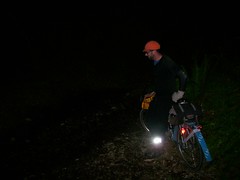
A couple of years ago, I did my first R300 by riding most of the
Barlow 300,
and got stuck with an extreme itch to revisit that route some time soon
(but without the 50km ferry move from Sellwood to Sandy.) Last year I
drew up an route for a R300 and did a check-ride that was not completely
successful thanks to
a section of tire-eating gravel road. So I went back and rearranged
the loop a little bit (dropping the Buckner Creek rollercoaster in
favo(u)r of going along the Clackamas River up to Barton, then climbing
up Judd Road (not so bad these days as it was last year; there’s apparently
enough traffic through there to flatten down the chipseal, if not the grade,)
wandering along backroads into Estacada before joining OR224 for the
run up to Ripplebrook, then replacing the route up NFD 5810 (steeeeep)
and NFD 5820 (gravel!) with a run up NFD 58 to the foot of High Rock, then
across to what I thought was a paved road dropping down to Timothy Lake, and
finally (100 km further down the road) getting away from US 26 at Zigzag and
taking Barlow Road, Marmot Road, and Lusted Road down to the road to Troutdale.
It was a little more climbing (~1500 feet, I thought?) but the absence of
gravel should reduce the chances of flat tire hell. A few friends had
expressed interest in riding it with me, but, alas, when the ride date
grew nigh one of them had to work, another one had a date, and a third
sensibly developed cold feet when he realized that it was going to be
within spitting distance of a 200 mile loop, leaving only Ed Groth as
a comrade in rando idiocy.
So on Saturday morning, at the somewhat more reasonable hour of ~7am,
we dragged ourselves out of Marsee Baking (400 feet from my front door;
when I make up a brevet route one of the important considerations is
that it start close to my front door) and headed off for Barlow Pass.
River Road is currently the least painful way to efficiently go from
Milwaukie to Oregon City; there’s one steepish climb at the start,
but it’s only 60 meters or so, and the local DOTs have narrowed River
Road by putting in two super-wide bicycle lanes, which means that you
can creep up the ramp without having to worry about blocking faster
and heavier traffic while you’re doing it. And then once you’re
in Oregon City, it’s only a mile or so to get onto Clackamas River
Drive, which is a lovely level grade that sees very little traffic
and becomes rural almost immediately after ducking into the lower
Clackamas River gorge.
Be aware, however, that our tax dollars are being used to completely
rebuild the OR213/I205 interchange, so the DOT has put in some nice
bike detour signs that direct the uncautious onto OR213 heading south,
which is not a good plan.
But once we worked that out and turned ourselves around (by travelling
along next to the jersey barriers at the edge of a narrow traffic
lane on OR213) we got out onto Clackamas River Drive and rolled on
east out to Carver, up Springwater to Baker’s Ferry Road, across
the Clackamas and up into Barton, then down to Amisegger Road and
up onto Judd Road, where, as is traditional, I raced and was dropped
by a banana slug that was out for its morning constitutional.
There is, however, a gratifyingly steep descent down off the mountain
spur that Judd Road climbs up; you give up 100 meters in about a
kilometer, starting with 200 meters at a 14% grade. And then you
(eventually) bounce along Eagle Creek Road into Estacada, where
the route deposits you right at the local Thriftway for the first
(and most important; there are basically no services except for
water from Estacada to Government Camp) control. We took what felt
like a leisurely break here, but which was only about 15 minutes,
then wandered off down OR224 towards Ripplebrook and points up.
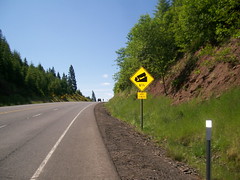
One very sad thing is that Faraday Road, which is a lovely river-level
PGE service road, has been closed by landslides. This is sad not
just because you lose the views, but that you have to use OR224 to
get around this landslide, and OR224 goes up over a spur of the
mountain to the tune of an 800 foot climb (at grades up to 9%) which
is only partially made up for by the more gradual descent down the
other side to river level.
But once you’re done with this, it’s about 20 miles of river-level
riding up to Ripplebrook. It’s not flat, of course – you’re riding
upstream along a mountain river – but it’s not nearly as hysterically
vertical as mountains can be. And the sun was out, and it was nice
and warm, so it was about as good a day for just riding around™ as
you can imagine. I took many pictures here as we rode up the river,
despite the limitations of my
horribly damaged CBC.
There is one short ramp just before Ripplebrook (where OR224 climbs
away from the Clackamas River before rejoining it along NFD 46)
but, as a welcome change from previous excursions, I managed to
make it all of the way up without falling over dead once. (I did
manage to derail the chain when I went into my alpine ring. Not
sure how I did that, but it’s something that’s very easy to correct.)
And at Ripplebrook there’s a nice ranger station with water spouts
out behind it and cold sodapop inside. Which is just the
thing for a second control, because Ripplebrook is only at 1500 feet
and the climb doesn’t top out until 4500 feet.
So once again we had a leisurely stop where I got rid of some weight
by finishing off a sandwich I’d bought in Estacada, then putting that
weight back by filling up my water bottles, and then we started up
the ramp towards High Rock.
NFD 57 starts out fairly steeply – a mile or so of 5-7% grades – but
then levels out and waits for the Oak Grove fork of the Clackamas River
to catch up to it. But after 8 miles of this it stops being paved
and becomes a gravel road for the next 7 miles up to Timothy Lake.
It’s not very steeply graded (there’s only a mile stretch where the
grade is steeper than 3%) but it is gravel, so it seems more prudent
to just turn onto NFD 58 for the climb up to the base of High Rock for
the info control I needed to place there.
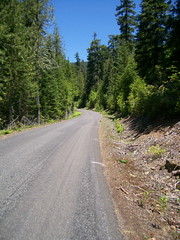
On the Barlow 300, the detour away from the gravel part of NFD57 was
to dodge up NFD 58 to NFD 5810, which is paved all the way to Anvil
Creek, but which then disappears for a kilometer or so and requires
a hike-a-bike and fording Anvil Creek before climbing up an embankment
to the other half of the road. And NFD 5810 starts out with a few miles
of stompingly steep climb, but then relents and becomes fairly level
up until the end of the road (NFD 5820 avoids the hikeabike section
at the cost of 5+ miles of tire-eating gravel, so we weren’t going to be
going there today.) But NFD 58 starts out with moderate grades
(there are a couple of hundred feet of steepish grade, but then it moderates
until it gets past the entrance to NFD 5810,) and then gradually begins
to pitch up more steeply.
And it doesn’t pitch up continually, either. It pitches up, then moderates,
then pitches up a little more, then moderates not quite so much. I spent a
large chunk of time climbing here first wondering why I was starting to
spin out, then (after correcting to a higher gear) wondering why it was
suddenly so difficult to pedal.
And then, as we climbed, I started to see little patches of snow
in the woods along the road, and then patches of snow in the ditches
along the road, and by the time we reached the site of the High Rock
info control (after a kilometer of 10-14% grades) the little patches
had become huge drifts tucked not too far away in the trees.
Ed parked in the shade while I set up some info questions, then we
continued east on NFD 58 (NFD 58 has some odd routing around High
Rock; the road actually loops around High Rock, but the two lobes
of the loop pinch together on a narrow ridge just to the east of
the offending rock. We headed east on the upper lobe
of NFD 58.
There’d been some traffic along the road as we headed up towards
High Rock, but not much. One truck passed us as we reached the
control, but we then encountered it again no more than a mile to
the east, and as they passed us they warned us that there was snow
on the road ahead. We thanked them, but continued onwards, because,
June?, and it would be nice to know if this loop was actually ridable
in summertime.
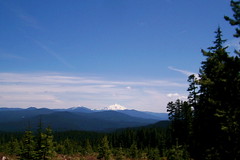
And, anyway, we had more things to occupy our mind. The views here
were absolutely spectacular, and I found myself actually starting to
stop the bicycle to try and get good photographs of what we saw as
we rolled up the line. First, of course, there was High Rock itself
(and, yes, I did stop on a 14% grade to get that picture), and then
we went around a curve where the forest to the south had been clearcut
and saw Mount Jefferson right there across the crest of the Cascades.
And, as we continued eastwards, we started to see fragments of Mount
Hood peeking through the trees whenever the road curved northish.
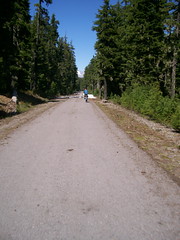
And we started to see some other stuff as well. Patches of snow that
weren’t obligingly sitting in the ditches or the woods, but which were
actually in the road. First they were small patches, but we curved
into the lee of a more thickly forested section and the patches got larger
and more substantial, and eventually reached a point where it was not
really so much a road anymore but was instead a path travelling through
the snow.
About a mile’s worth of snowy path going through the snow, actually.
And it was densely packed wet snow so there wasn’t even the slightest
hope of being able to ride my bicycle through it. So I shouldered the
thing and cyclocrossed my way through the winter wonderland, stopping
occasionally to take more pictures and laugh at the ridiculousness of
the whole thing.
If the snowy part of the loop had gone on too far, it would have put
a severe crimp into the plan of finishing, but the road was trending
downgrade and it dropped below the snowline at ~4300 feet. So back
on the bicycles and on we went towards NFD 5860, which I had foolishly
thought was paved due to the state of the road closer to Timothy Lake.
I was wrong about the paving. NFD 5860 is a unsigned gravel path
descending 1100 steep feet down to Timothy Lake, and it’s not very
much shorter than just taking NFD 58 out to Skyline, then backtracking
to Clackamas Lake. Ed and I went screaming down this path at
full speed (Ed converted to 650B wheels on his rando bike, so he’s
got traction to spare; the MLCM, on the other hand, is still using
Nashbar Duro tires like last year, so I did more of a slither down
this ramp and didn’t really get the chance to take any pictures documenting
the atrocities.)
And at Timothy Lake, we were back on a once-again-paved NFD57, which
we took up to NFD 42, and then back half a mile west to the Clackamas
Lake Ranger Station, which is not just an info control but a water
stop, which we took full advantage of during a very leisurely
pause to catch our breath.
And then up again and to the east. NFD 42 takes you out to US 26, climbing
most of the way, and then you give up most of that climb dropping down to
NF 43, which rollers along over to the White River Valley giving occasional
spectacular views of Mount Hood as well as the quieter but equally lovely
ride through pine forests in the late afternoon.
And then down a steep ramp into the White River Valley, which has the last
info control on the loop, and then a turn onto NFD 48, which climbs up toward
Barlow Pass.
Last time (on the Barlow 300) it was dark by the time I’d reached this point
of NFD 48, so the only views I had of Mount Hood were it just shining ghostly
white against the night sky. It was impressive then, but ohmygod the views
on this loop were so much better. Mount Hood was right there every time
we rode around a spur that blocked our view, getting bigger and bigger
every time it popped into view. And all this framed against the almost
unnatural green forest that comes from a rainy springtime, and the huge
uncluttered sky that comes with it being up on the mountain.
NFD 48 pops out onto OR 35 just east of the White River valley (which,
up that far, is on a bed of layers and layers of lahars; the DOT is
in the throes of building a new taller viaduct across the valley floor.
presumably because they’re kind of sick of bulldozing hundreds of tons
of ash and gravel off the road every spring) and OR 35 joins up with US 26
a couple of miles east of Government Camp, which we rolled into just before
8pm, and then stopped for a hour to have the dinner that our stomachs had
been screaming for for the last hour and a half.
The spectacular part of the loop as pretty much over now; we left the
Huckleberry Inn at ~9pm, when the sun was about to go into a terminal
plummet towards the horizon, and the evening cold blast was already
warming up. So, despite layering up with all of the clothes I had
brought along for just this reason, I was shivering enough to make me want to pay most of
my attention to the road, which in addition to the cold was in the
throes of being rebuilt, which converted the formerly wide bicycle lanes
into pretty much nothing at all.
So down we shot towards Zig-zag, Ed pulling a long way ahead on the
initial descent but then me catching up when we dropped into a warmer
layer down around 3000 feet.
The plan was that we’d ride on US 26 down to Zigzag, the hop over to
the Barlow Road and take it, Marmot, and Lusted into the vicinity of
Troutdale. But Ed had other plans – his GPS unit has maps that show
bicycle trails as well as auto-passable roads, and he’d seen that NF 19
(a discontinued section of the Barlow Road) was still marked as accessable
to bicycles from Rhododendron to Zigzag – and suggested a slight route
variation that would take us off US 26 a mile or so ahead of the original
plan.
Sure, why not?
It did turn out to be basically singletrack instead of a road or
even a path (complete with sections where streams had washed out
the path and you had to carry your bike around gravelled shooflies)
but it did get through in a very bumpy (and I’m sure pretty, but it
was too dark for me to verify that) way. I’m not going to put it
onto the final R300, though, because not everyone is willing to
toss their rando bikes onto mountain biking paths!
And then in Zigzag we finally diverged onto a paved part of the Barlow
Road, and charged down towards Troutdale and Portland in the dark.
I discovered that the ramps on the east side of Devil’s Backbone
are steep enough so that it doesn’t help when you climb them in the
dark, but the Lusted Road ramp out of the Sandy River gorge seems
much less steep when you don’t have any visual cues about where
you are, and the Dodge Park Blvd (ex Mount Hood Railway) ramp seems
like it’s almost level when you can’t see anything.
And from Dodge Park Blvd, we dodged south through Pleasant Home to
Lusted (again), then west of Lusted to Troutdale Road, and thus
down into the last control at Troutdale. And after a brief stop
for fud and water at the Plaid Pantry there, we rolled west towards
the end of the line at, if not the most sprighty speed possible,
at least as a speed that guaranteed finishing the checkride within
20 hours.
Ed split off to head home at 28th Ave, but I finished the route as
mapped, arriving home at ~2:20am. The gory details of the loop are:
- 189 miles, including .5 bonus miles
- 9.7 mph brevet average
- 19h32 minutes brevet time, of which 16h was spent moving
- ~15,000 feet of climbing
- 53 pictures published out of 170 taken.
- Approximately 20 hours for rando amnesia to set in :-)
—orc Mon Jun 27 17:35:01 2011
Jun 26, 2011
Ed Groth and I did a checkride of my Sellwood to Hood & Back R300 yesterday/this morning and it was about the perfect weather for doing a nice long loop
303 km (the final will be ~305km when I correct some of the routing that took us on unsigned gravel roads that the maps claimed were actually signed and paved) and ~15,000 feet of climbing in 19h32. With pictures and, as soon as I get the mental energy, a full write-up.
—orc Sun Jun 26 11:13:58 2011
Jun 25, 2011
The RossIsle was steaming south while I was steaming north, but I was the one who turned around to follow it.
—orc Sat Jun 25 00:06:35 2011
Jun 24, 2011
A streetcar in transit in Albina Yard.
—orc Fri Jun 24 23:08:31 2011
The CBC almost manages to get a fast-moving F59 into focus as it zips on by at dusk.
—orc Fri Jun 24 23:05:53 2011
Jun 23, 2011
I went out to take a couple of loops around Mount Scott this afternoon, but because I was being slothful I didn’t actually make it out the door until about 6pm. But it turned out not to be a total waste, because I reached the Springwater Trail bridge over the Yellow Menace about 60 seconds before train #507 did.
—orc Thu Jun 23 21:06:37 2011
The bears while away some time in the car by looking at a comic book.
—orc Thu Jun 23 13:28:11 2011
Jun 22, 2011
A Yellow Menace locomotive approaches Brooklyn Yard after running light through East Portland.
—orc Wed Jun 22 20:51:59 2011
After ~4000 miles, I think it might be time to consider retiring the front tire on the mlcm. This is the second flat in the last 650 miles after 3300 miles of flatlessness,
and I’m planning on riding Sellwood to Hood & back on Saturday, so I don’t want to encourage the millions of flats that happened last time I rode this loop.
Not bad value for a $15 tire; good thing I’ve got about 3 more of them in reserve.
—orc Wed Jun 22 00:31:10 2011
Jun 21, 2011
A customised giant rando bag with a zip-out lining. Fortunately after a few attempts to pin the zipper in place I threw in the towel and bought some water-soluble tape to pin the zipper to the bag and the lining. What would have been a many-hour job turned into about 45 minutes after I was able to actually keep the bias tape and zipper in place while sewing it together on the mighty Pfaff 130.
—orc Tue Jun 21 22:45:17 2011
Trolleys & bicycles at Flavel St. Station.
—orc Tue Jun 21 22:42:12 2011
Jun 19, 2011
A vine with lovely purple flowers is in the process of being overwhelmed by a tsunami of morning glory. And, unlike the english ivy that I finally got rid of by nuking the infestation from orbit (aka “submerging it under 3 inches of Roundup”), the horrible morning glory is tightly entwined around rose bushes, ferns, and flowering plants I actually want to keep.
—orc Sun Jun 19 23:56:56 2011
Jun 18, 2011
This house caught my attention when I was returning home from Noah’s Bagels this afternoon, and I had to stop and take a few pictures. It’s for sale, too, at a reduced price of $470,000, which begs the question of just how did the USA jump into the property bubble that ate the economy 3 years ago?
I mean it’s a really pretty house and all, but if you’re not independently wealthy doesn’t $470k translate to about a $3000/month mortgage? If I lived there I suspect I’d rapidly become very sick of modern architecture when my bank account was being emptied at that rapid rate before dealing with trivialities like food and the rent-seeking that calls itself healthcare in this country.
And that would be a shame because I like the house. Maybe I’ll get a lottery ticket and buy it for a summer house!
—orc Sat Jun 18 23:31:42 2011
A few months ago, when one of my pairs of nashbar +4s started to disintegrate (I’d been working last summer, and as a result my weight shot up; this additional weight made the +4s a bit to tight, and the fabric started to wear out as if there was no tomorrow) I decided that I’d try a pair of Rivendell “MUSA” +4s out because they weren’t much more expensive than the nashbar ones, they are made in the USA, and several of my bikey friends wear them and didn’t have any complaints about them aside from them being warm in the summer.
So I’ve been wearing them off and on. Mainly off, because they’ve got some problems.
Firstly, despite appearances, they don’t have a fly. There are seams and sewing on the fronts as if there should be one, but it’s a cruel lie. That’s annoying, but it’s pretty easy to work around in the traditional way.
Secondly, the fit is a bit odd. My waist fluctuates between 32" and 34" (depending on whether I’m working or not – computer programming is a pretty horrible job, and to survive it I self-medicate with junk food, with the expected horrible results to my health,) which should fit into the “medium” category, but I find that these +4s are loose around the waist, but tight around my upper legs. And this leads to the …
Third issue, which is that they don’t really have a cyclist cut. They’re cut fairly low around the hips, which means, for me, that when I’m in my usual hunched over the drops position that they want to ride down plumber-style. And they come with an elastic belt, so even if I tighten the belt up to the point where it’s becoming painful the stupid elastic will still stretch and let the +4s ride on down as soon as I get into the drops and attempt to move on down the road.
Fourthly, the pockets. These +4s don’t come with a cellphone pocket, which is moderately annoying (the trek doesn’t have a front rack yet, so I have to wear a bikey-style jersey with back pockets when I’m wearing these on grocery store trips), and the front pockets are astoundingly deep, to the point where my wallet and keys drop low enough on my legs to rub against my thighs when I’m cranking along at 18-20mph. It’s really annoying, particularly when I have to stop to empty my pockets into the big rando bag in mid-loop.
Lastly, the fabric, despite being nice and light and quick-drying, is fairly rough on the inside. On hot days, I like having the bottoms of my +4s flapping in the breeze to ventilate my legs, but when I do that with the MUSA +4s they cling to my hips and abrade away at my knees until I cinch the legs tight.
It would be unfair to simply list all of the disadvantages of these +4s but not list the advantages, though, so
- they are made in the United States, which keeps money circulating inside the Imperium instead of it going overseas before being dumped into the Scrooge McDuck-like moneybins of the parasitic class,
- they have reflective patches on them, which are not garish enough to be ridiculous but which appear to do a good job of alerting drivers of your presence.
But I’m not sure what the ideal body type for the Rivendell +4s is. It’s not me. I’m not sure what the ideal cycling position is for the Rivendell +4s is. It’s certainly not me; I have my handlebars about 6cm lower than my saddle these days, and I spend more than half my time in the drops, which makes the low cut seat of these +4s painfully obvious.
I don’t think I’ll be buying any more of these when/if this pair wears out; to make them properly usable I’ll need to cut the pockets down (so they won’t go all the way to mid-thigh), put a zippered fly in, rip out the useless elastic belt, and thread a non-elastic belt through the (no belt loops because that would be sensible) too-short waist.
And if I’m going to all of that trouble I’d be better off buying Swrve sprinter cut knickers, which are only 1.5× as expensive, last about 10,000 miles, and only suffer from flimsy pocket syndrome (which is, I suppose, to be expected; most long-distance cyclists don’t tend to wear pants with pockets, so aren’t likely to have to worry about their wallets and keys wearing holes in their pockets.) And the Swrve +4s come with belt loops, so I can wear a real belt instead of some sort of elastic belty substitute that almost, but not quite, works as a belt.
(And, in case you’re wondering, no, I’m not likely to wear lycra or woolen tights, because I like having my wallet, keys, and money at hand when I’m out on the line. Plus basically all cycling tights come with chamois, which is not a clothing style I’ve ever gotten used to.)
—orc Sat Jun 18 22:35:54 2011
Jun 17, 2011
Dust Mite examines the gigantic rando bag I’ve sewn up for my friend Graydon (the teeny little bag it’s resting on is my big rando bag, which looks positively petite compared to this one.)
—orc Fri Jun 17 23:53:51 2011
Jun 14, 2011
My Pentax is a good camera (good enough so that when I crunched my original one past the point where I could restore it to life I went out and bought a new one instead of upgrading to a nice mirrorless camera) but the image sensor is really sensitive to red, to the point where a highly saturated red (a poppy petal, for example, with the sun shining through it) will, without heroic efforts, completely wash out the reds and end up with a photo that looks as if someone poured fluorescent red poster paint onto the image.
Possibly a red filter would do the trick?
—orc Tue Jun 14 16:06:47 2011
Jun 13, 2011
Jun 12, 2011
A very tiny battleship defends the Westmoreland casting pond.
—orc Sun Jun 12 20:59:43 2011
It’s not our cat, but it is still very interested in my shoes.
—orc Sun Jun 12 20:55:30 2011
Jun 11, 2011
Bridge over the River Clackamas
—orc Sat Jun 11 22:25:40 2011
Jun 10, 2011
Dust Mite celebrates the beginning of the peach season.
—orc Fri Jun 10 22:48:36 2011
I had a bicycle, an ebayed pair of used brifters, the older 9-speed cassette from the mlcm, and a pair of equally-worn chains from the same source. But what I didn’t have was a pair of downtube cable stops – I had a right side cable stop, but when I won that auction the seller sent me two right-hand stops instead of a right and a left.
So, after a couple of days wait to see if the seller would quickly send me the left cable stop, I snapped and made an unnatural hybrid bike with a friction-shifting front derailer and an indexed rear. Which, amazingly, actually works.
When I sell off the old rear derailer, the brake levers, and the downtube (Rivendell Silver) shifters I should have enough money to buy two more 9-speed chains and an econocassette, and then I’ll have an unnatural hybrid that doesn’t do chain-jumping when I shift to the 14t and 12t gears.
—orc Fri Jun 10 16:05:12 2011
Jun 08, 2011
Some over the shoulder photos with my non-viewfindered CBC work out better than others do.
—orc Wed Jun 8 22:15:16 2011
Jun 07, 2011
It was not nearly as dark as this picture claims when I sailed through Share-it Square earlier this evening.
—orc Tue Jun 7 21:54:19 2011
Jun 06, 2011
X marks the bicycle boulevard.
—orc Mon Jun 6 22:47:36 2011
Jun 05, 2011
An over-the-shoulder view of the new replacement working Eng! as it pulls a train north towards the East Portland yard.
—orc Sun Jun 5 16:51:17 2011
A bees-eye view of the first (and only, from the looks of it) yard poppy of the year.
—orc Sun Jun 5 13:54:19 2011
Jun 04, 2011
I took a photo break before stuffing the donuts into the big rando bag.
—orc Sat Jun 4 22:00:12 2011
I was thinking I’d preride my Sellwood-Devil’s Backbone populaire one more time before packaging it up and submitting it to RUSA as a permanent, but I kept getting distracted by route variations (some of which were online-map-only variations; 329th St, for instance, does not become Colorado and then go into Sandy, but dead-ends at a keypad-locked gate with a big “THIS IS NOT A PUBLIC ROAD” sign by it) and some stupidly steep ramps (Proctor Road goes up an at least 20% ramp from Dodge Park Blvd to Bluff Road. Thank goodness for the recently-added 34t climbing ring.) But even though I failed the preride, I still made it up to the turnaround point and managed to get a photo of the mlcm propped up against the signpost that’s at approximately the summit of Devil’s Backbone.
Note that the old silver crankset has been replaced with a traditional compact double, in black, and that
the rando bag is, once again, filled with donuts from the usual place.
—orc Sat Jun 4 20:01:24 2011
Jun 03, 2011
Mount Hood looms in the distance.
—orc Fri Jun 3 20:29:48 2011
Jun 01, 2011
A super-large rando bag I’m making for a friend. This one is 32×22×15cm, with a 5cm deep front pocket, 2 5×10×15cm rear pockets, and a couple of 3cm deep side pockets with elastic in the tops (the elastic is fighting it out with the fabric and, I’m afraid, losing; I need to unsew one end of the elastic band and draw it a whole bunch tighter to make it close up more.)
(And when I get it sewn together, I’m going to set it in the shower and let it be showered on for about 5 minutes to see just how waterproof it will be.)
The interfacing is sticking out from the top of the bag because I’ve not yet sewn everything together; one of the requests for this bag is a removable waterproof lining, which will require a 37 inch separable zipper, and those are moderately difficult to find and I’m not going to sew the whole shebang together until I’ve either sourced a nice one or devised a workaround!
—orc Wed Jun 1 21:05:23 2011
—30—
